 W
WThis is a list of fermented foods, which are foods produced or preserved by the action of microorganisms. In this context, fermentation typically refers to the fermentation of sugar to alcohol using yeast, but other fermentation processes involve the use of bacteria such as lactobacillus, including the making of foods such as yogurt and sauerkraut. The science of fermentation is known as zymology.
 W
WThis is a list of pickled foods. Many various types of foods are pickled to preserve them and add flavor. Some of these foods also qualify as fermented foods.
 W
WAppam is a type of pancake, originating from South India, made with fermented rice batter and coconut milk, common in Kerala, Sri Lanka, Tamil Nadu. It is eaten most frequently for breakfast or dinner.
 W
WAtchara, is a pickle made from grated unripe papaya popular in the Philippines. This dish is often served as a side dish for fried or grilled foods such as pork barbecue.
 W
WBánh cuốn is a Vietnamese dish originating from Northern Vietnam.
 W
WBanku is a local term in the Ga-Dangme (Ga)-language coined for a cooked slightly-fermented mixture of corn-dough and cassava-dough made into dumpling to serve. It is distinctively a Ga-Dangme term. There are similar tonal terms with different meaning in the Ga-language, such as Inku, Ashanku, and many others ending in 'Ku'.
 W
WBorș is either (1) a liquid ingredient used in Romanian and Moldovan cuisine or (2) the sour soup (ciorbă) typically made with this ingredient.
 W
WBrem is traditional fermented food or fermented beverage from Indonesia. There are two types of brem, brem cake (solid) that is usually eaten as snack from Madiun and Wonogiri, and brem beverage (liquid) made of rice wine from Bali and Nusa Tenggara, but mostly known from Bali. Brem first appeared in Java around the year 1000, based on investigations regarding old Javanese inscriptions and literature.
 W
WCurtido is a type of lightly fermented cabbage relish. It is typical in Salvadoran cuisine and that of other Central American countries, and is usually made with cabbage, onions, carrots, oregano, and sometimes lime juice; it resembles sauerkraut, kimchi, or tart cole slaw. It is commonly served alongside pupusas, the national delicacy.
 W
WDhokla is a vegetarian culinary dish that is found mainly in the Indian state of Gujarat and parts of adjacent states. It is made with a fermented batter derived from legumes like Chickpea, Pigeon pea and Urad and rice. Dhokla can be eaten for breakfast, as a main course, as a side dish, or as a snack. Dhokla is very similar to Khaman, however Khaman is typically made from Chickpeas gram and looks yellow in color. Khaman has become widely popular outside Gujarat but is misunderstood or incorrectly known as Dhokla.
 W
WA dosa is a thin pancake or crepe originating from South India, made from a fermented batter predominantly consisting of lentils and rice. It is somewhat similar to a crepe in appearance, although savoury flavours are generally emphasized. Its main ingredients are rice and black gram, ground together in a fine, smooth batter with a dash of salt, then fermented. Dosas are a common dish in South Indian cuisine, but now have become popular all over the Indian subcontinent. Dosas are served hot along with chutney by tradition and sambar in recent times. Other accompaniments include chutney powder.
 W
WFesikh or fseekh is a traditional celebratory ancient Egyptian dish. It is eaten by the Egyptians during the Sham el-Nessim festival in Egypt, which is a spring celebration from ancient Egyptian times and is a national festival in Egypt. Fesikh consists of fermented, salted and dried gray mullet of the genus Mugil, a saltwater fish that lives in both the Mediterranean and the Red Seas.
 W
WFunge or fúngi (Angola) or mfundi is a type of porridge or swallow that can be made with sorghum, maize or millet grains, or cassava. It can be served with stew, or a vegetable or meat dish. It may be made with a stiffer consistency to be eaten with the fingers. Funge is a staple food in African cuisine. Some richer and more flavorful versions may be made with stock, like fish stock, instead of water. It is also known as bidia.
 W
WIn West Africa, garri refers to the creamy granular flour obtained by processing the starchy tuberous roots of freshly harvested cassava.
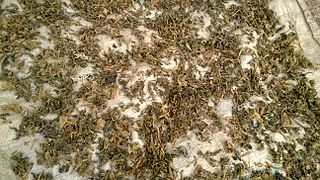 W
WGundruk is a fermented leafy green vegetable and a popular food in Nepal, and it is claimed to be one of the national dishes. It is popular not only in Nepal but also in Gorkhali or Nepalese diaspora households worldwide. The annual production of gundruk in Nepal is estimated at 2,000 tons and most of the production is carried out at the household level. Gundruk is obtained from the fermentation of leafy vegetables. It is served as a side dish with the main meal and is also used as an appetizer. Gundruk is an important source of minerals, particularly during the off-season when the diet consists of mostly starchy tubers and maize, which tend to be low in minerals.
 W
WIdli or idly are a type of savoury rice cake, originating from the Indian subcontinent, popular as breakfast foods in Southern India and in Sri Lanka. The cakes are made by steaming a batter consisting of fermented black lentils (de-husked) and rice. The fermentation process breaks down the starches so that they are more readily metabolised by the body.
 W
WInjera is a sour fermented flatbread with a slightly spongy texture, traditionally made of teff flour. In Ethiopia, Eritrea, and some parts of Sudan, injera is the staple; also eaten in other countries in East Africa, injera is central to the dining process, like bread or rice elsewhere. This food item is almost similar to South Indian dosa.
 W
WIrú or Eware (Edo) is a type of fermented and processed locust beans used as a condiment in cooking. It is similar to ogiri and douchi. It is very popular among the Yoruba people and Edo people of Nigeria. It is used in cooking traditional soups like egusi soup, okro soup, Ewedu soup and ogbono soup. Among the Manding-speaking people of West Africa irú is known as sumbala. The Yorubas classify iru into two types: Irú Wooro which is commonly use in making stew and Irú pẹ̀tẹ̀ which is used in making ewedu and egusi soup.
 W
WIn Korean culture, Jangdokdae or Jangttokttae is an outside space, most frequently a terrace, used to store or ferment food. Foods such as Kimchi, soybeans, grains, and bean and red pepper paste, are placed in Jangdok earthenware jars which are then placed on the Jangdokdae.
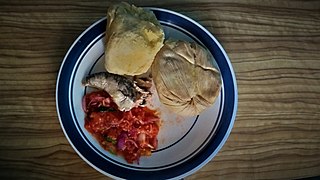 W
WKenkey is a staple dish similar to sourdough dumpling from the Ga and Fante-inhabited regions of West Africa, usually served with pepper sauce and fried fish or soup, stew.
 W
WKhanom chin are fresh, thin rice noodles in Thai cuisine which are made from rice sometimes fermented for three days, boiled, and then made into noodles by extruding the resulting dough through a sieve into boiling water. Khanom chin is served in many kinds of stock: coconut milk, fish curry, and chilli. Although chin means "Chinese" in Thai, this type of noodle originated from the Mon people who inhabited the region which is now central Thailand The word khanom chin is probably derived from the Mon words hanom cin, or "boiled noodles."
 W
WLahoh, also laḥūḥ, meaning "flat" in Arabic from the Arabic root word "lowh" ("لوح"), is a spongy, flat pancake-like bread that originated from Somalia. It is a type of flat bread eaten regularly in Somalia, Somaliland, Djibouti, Ethiopia and Yemen, and Yemenite Jewish immigrants have popularized the dish in Israel. It is called Laxoox/Lahoh or Canjeero in Somaliland, Somalia and Djibouti, and called Lahoh/Lahuh in Yemen, respectively.
 W
WLebkuchen, Honigkuchen or Pfefferkuchen, is a honey-sweetened German cake molded cookie or bar cookie that has become part of Germany's Christmas traditions. It is similar to gingerbread.
 W
WMasala dosa is a variation of the popular South Indian dosa, which has its origins in Tuluva Udupi cuisine Karnataka. It is made from rice, lentils, potato, fenugreek, ghee and curry leaves, and served with chutneys and sambar. It is popular in South India, it can be found in all other parts of the country and overseas. In South India, preparation of masala dosa varies from city to city. There are variations in Masala dosa like Mysore masala dosa, Rava masala dosa, Onion masala dosa, Paper masala dosa, Cheese masala dosa etc.
 W
WMixian is a type of rice noodle from the Yunnan Province, China. It is made from ordinary non-glutinous rice, and it is generally sold fresh rather than dried.
 W
WPaddu is an Indian dish made by steaming batter using a mould. It is named variously kuzhi paniyaram, paniyaram, paddu, guliyappa, yeriyappa, gundponglu, gunta ponganalu, or Tulu: appadadde, appe. The batter is made of black lentils and rice and is similar in composition to the batter used to make idli and dosa. The dish can also be made spicy or sweet with chillies or jaggery respectively. Paniyaram is made on a special pan that comes with multiple small indentations.
 W
WPesaha appam or Inriyappam or Kurisappam is the unleavened Passover bread made by the Saint Thomas Syrian Christians of Kerala, India to be served on the night of Maundy Thursday. The whitish Pesaha appam is a firm rice cake. It is made from rice batter like palappam, but is different from palappam in that Pesaha appam is not fermented with yeast in its preparation. The meal also includes small banana variants in Kerala such as poovan pazham or njalipoovan pazham. The brown palkurukku is made mainly using jaggery and coconut milk. A cross is made using the palm leaves from Palm Sunday and placed in the middle of the batter.
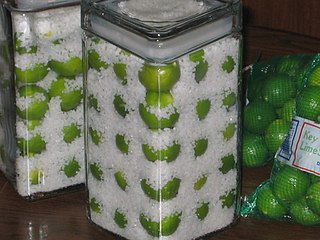 W
WPickled fruit refers to fruit that has been pickled. Pickling is the process of food preservation by either anaerobic fermentation in brine or immersion in vinegar. Many types of fruit are pickled. Some examples include peaches, apples, crab apple, pears, plums, grapes, currant, tomato and olives. Vinegar may also be prepared from fruit, such as apple cider vinegar.
 W
WPla ra, similar to padaek in Laos, is a traditional Thai seasoning produced by fermenting fish with rice bran or roasted rice flour and salt fermented in a closed container for at least six months. Fermented fish seasoning are commonly found in Cambodian, Lao, Mon, Thai and Vietnamese cuisine. Pla ra has a very strong smell, which is considered unpleasant by some people. Its flavors are salty and sour, depending on the amount of salt put in and lactic acid resulting from fermentation process.
 W
WPoi or Popoi is a traditional staple food in the Polynesian diet, made from starchy vegetables, usually breadfruit, taro or plantain.
 W
WPulque, or octli, is an alcoholic beverage made from the fermented sap of the maguey (agave) plant. It is traditional in central Mexico, where it has been produced for millennia. It has the color of milk, a rather viscous consistency and a sour yeast-like taste.
 W
WPuto is a Filipino steamed rice cake, traditionally made from slightly fermented rice dough (galapong). It is eaten as is or as an accompaniment to a number of savoury dishes. Puto is also an umbrella term for various kinds of indigenous steamed cakes, including those made without rice. It is a sub-type of kakanin.
 W
WRed yeast rice, red rice koji, red fermented rice, red kojic rice, red koji rice, anka, or angkak, is a bright reddish purple fermented rice, which acquires its color from being cultivated with the mold Monascus purpureus. Red yeast rice is what is referred to as a "koji" in Japanese, meaning "grain or bean overgrown with a mold culture", a food preparation tradition going back to ca. 300 BC. In both the scientific and popular literature in English that draws principally on Japanese traditional use, red yeast rice is most often referred to as "red rice koji." English language articles favoring Chinese literature sources prefer the translation "red yeast rice."
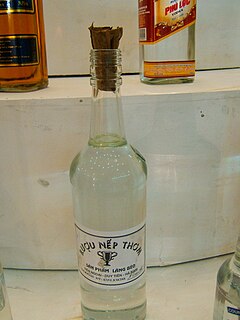 W
WRượu nếp is a pudding or drink from northern Vietnam.
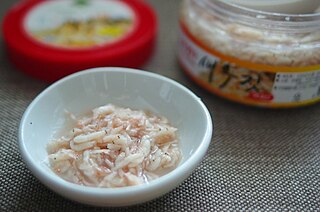 W
WSaeu-jeot (새우젓) is a variety of jeotgal, salted and fermented food made with small shrimp in Korean cuisine. It is the most consumed jeotgal along with myeolchi-jeot in South Korea. The name consists of the two Korean words, saeu and jeot. Saeu-jeot is widely used throughout Korean cuisine but is mostly used as an ingredient in kimchi and dipping pastes. The shrimp used for making saeu-jeot are called jeot-saeu (젓새우) and are smaller and have thinner shells than ordinary shrimp.
 W
WSCOBY is the commonly used acronym for "symbiotic culture of bacteria and yeast", and is formed after the completion of a unique fermentation process of lactic acid bacteria (LAB), acetic acid bacteria (AAB), and yeast to form several sour foods and beverages such as kombucha and kimchi. Beer and wine also undergo fermentation with yeast, but the lactic acid bacteria and acetic acid bacteria components unique to SCOBY are usually viewed as a source of spoilage rather than a desired addition. Both LAB and AAB enter on the surface of barley and malt in beer fermentation and grapes in wine fermentation; LAB lower the pH of the beer while AAB take the ethanol produced from the yeast and oxidize it further into vinegar, resulting in a sour taste and smell. AAB are also responsible for the formation of the cellulose SCOBY.
 W
WShiokara (塩辛) lit. 'salty-spicy', is a food in Japanese cuisine made from various marine animals that consists of small pieces of meat in a brown viscous paste of the animal's heavily salted, fermented viscera.
 W
WSikhae is a salted fermented food in Korean cuisine prepared with fish and grains. Sikhae is made in the east coast regions of Korea, namely Gwanbuk, Gwandong, and Yeongnam.
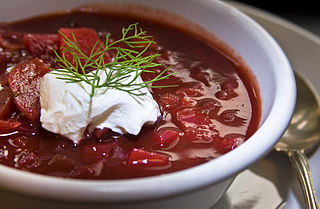 W
WSmetana is a type of sour cream from Central and Eastern Europe. It is a dairy product produced by souring heavy cream. It is similar to crème fraîche, but nowadays mainly sold with 9% to 42% milkfat content depending on the country. Its cooking properties are different from crème fraîche and the lighter sour creams sold in the US, which contain 12 to 16% butterfat. It is widely used in cooking and baking.
 W
WSourdough is a bread made by the fermentation of dough using wild lactobacillaceae and yeast. Lactic acid from fermentation imparts a sour taste and improves keeping qualities.
 W
WSsamjang is a thick, spicy paste used with food wrapped in a leaf in Korean cuisine. The sauce is made of doenjang, gochujang, sesame oil, onion, garlic, green onions, and optionally brown sugar.
 W
WSumbala or soumbala is a fermented seed condiment used widely across West Africa. It is usually prepared by women over the course of several days, traditionally from néré seeds. It can be made from other kinds of seeds, such as those of Prosopis africana, and the use of soybeans for this purpose is increasing due mainly to inadequate supply of néré seeds. It is comparable to miso paste.
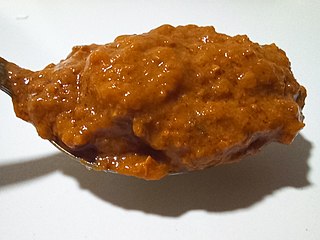 W
WTaba ng talangka, also known simply as aligi, is a Filipino seafood paste derived from the roe and reddish or orange tomalley of river swimming crabs or Asian shore crabs (talangka).
 W
WTapai, is a traditional fermented preparation of rice or other starchy foods, and is found throughout much of Southeast Asia, especially in Austronesian cultures, and parts of East Asia. It refers to both the alcoholic paste and the alcoholic beverage derived from it. It has a sweet or sour taste and can be eaten as is, as ingredients for traditional recipes, or fermented further to make rice wine. Tapai is traditionally made with white rice or glutinous rice, but can also be made from a variety of carbohydrate sources, including cassava and potatoes. Fermentation is performed by a variety of moulds including Aspergillus oryzae, Rhizopus oryzae, Amylomyces rouxii or Mucor species, and yeasts including Saccharomyces cerevisiae, and Saccharomycopsis fibuliger, Endomycopsis burtonii and others, along with bacteria.
 W
WTarhana is a dried food ingredient, based on a fermented mixture of grain and yoghurt or fermented milk, found in the cuisines of Southeast Europe and the Middle East. Dry tarhana has a texture of coarse, uneven crumbs, and it is usually made into a thick soup with water, stock, or milk. As it is both acidic and low in moisture, the milk proteins keep for long periods. Tarhana is very similar to some kinds of kashk.
 W
WTempoyak or asam durian is a Malay condiment made from fermented durian. It is usually consumed by the ethnic Malays in Maritime Southeast Asia, notably in Indonesia and Malaysia. Tempoyak is made by taking the flesh of durian and mixing it with some salt and kept in room temperature for three or five days for fermentation. Tempoyaks are usually made during the durian season, when the abundance of durian and excess production are made into fermented tempoyak.
 W
WTibicos, or water kefir, is a traditional fermented drink made with water and a symbiotic culture of bacteria and yeasts (SCOBY) held in a polysaccharide biofilm matrix created by the bacteria. It is sometimes consumed as an alternative to milk-based probiotic drinks or tea-cultured products such as kombucha. Water kefir is typically made as a probiotic homebrew beverage. The finished product, if bottled, will produce a carbonated beverage.
 W
WTorshi are the pickled vegetables of many Middle Eastern and Balkan cuisines.
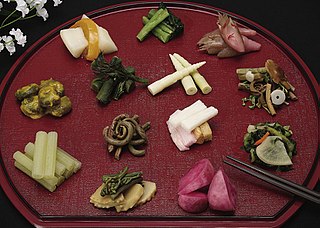 W
WTsukemono are Japanese preserved vegetables. They are served with rice as an okazu, with drinks as an otsumami (snack), as an accompaniment to or garnish for meals, and as a course in the kaiseki portion of a Japanese tea ceremony.
 W
WTupí, also known as formatge de tupí, is a fermented cheese of a certain area of the Pyrenees and Pre-Pyrenees made from cows' or sheep's milk.
 W
WWhite sugar sponge cake is a type of Chinese pastry.
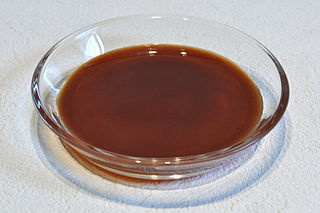 W
WWorcestershire sauce is a fermented liquid condiment created in the city of Worcester in Worcestershire, England during the first half of the 19th century. The creators were pharmacists John Wheeley Lea and William Henry Perrins, who went on to form the company Lea & Perrins. Worcestershire sauce has been considered a generic term since 1876, when the English High Court of Justice ruled that Lea & Perrins did not own a trademark for the name Worcestershire.
 W
WYongfeng chili sauce or Yongfeng hot sauce is a traditional product made at Yongfeng, Shuangfeng County, Hunan, China. It is recognized by China as a Geographical Indication Product.